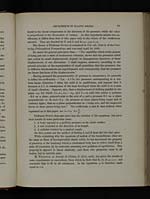James Clerk Maxwell (1831-1879)
On the equilibrium of elastic solids
EQUILIBRIUM OF ELASTIC SOLIDS.
89
tional to the linear compression in the direction of the pressure, while the other
is proportional to the diminution of volume. As this hypothesis admits two co-
efficients, it differs from that of this paper only in the values of the coefficients
selected. They are denoted by K and k, and K=µ — 1/3 m, k = m.
The theory of Professor STOKES is contained in Vol. viii., Part 3, of the Cam-
bridge Philosophical Transactions, and was read April 14, 1845.
He states his general principles thus:— “The capability which solids possess
of being put into a state of isochronous vibration, shews that the pressures called
into action by small displacements depend on homogeneous functions of those
displacements of one dimension. I shall suppose, moreover, according to the
general principle of the superposition of small quantities, that the pressures due
to different displacements are superimposed, and, consequently, that the pressures
are linear functions of the displacements.”
Having assumed the proportionality of pressure to compression, he proceeds
to define his coefficients.— “ Let A δ be the pressures corresponding to a uni-
form linear dilatation δ when the solid is in equilibrium, and suppose that it
becomes m A δ, in consequence of the heat developed when the solid is in a state
of rapid vibration. Suppose, also, that a displacement of shifting parallel to the
plane xy, for which δx = kx, δy = –ky, and δz = 0, calls into action a pressure
–Bk on a plane perpendicular to the axis of x, and a pressure B k on a plane
perpendicular to the axis of y; the pressure on these planes being equal and of
contrary signs; that on a plane perpendicular to z being zero, and the tangential
forces on those planes being zero.” The coefficients A and B, thus defined, when
expressed as in this paper, are A = 3 µ, B= m/2.
Professor STOKES does not enter into the solution of his equations, but gives
their results in some particular cases.
1. A body exposed to a uniform pressure on its whole surface.
2. A rod extended in the direction of its length.
3. A cylinder twisted by a statical couple.
He then points out the method of finding A and B from the two last cases.
While explaining why the equations of motion of the luminiferous ether are
the same as those of incompressible elastic solids, he has mentioned the property
of plasticity or the tendency which a constrained body has to relieve itself from a
state of constraint, by its molecules assuming new positions of equilibrium. This
property is opposed to linear elasticity; and these two properties exist in all
bodies, but in variable ratio.
M. WERTHEIM, in Annates de Chimie, 3e Série, xxiii., has given the results of
some experiments on caoutchouc, from which he finds that K = k, or µ = 4/3 m; and
concludes that k = K in all substances. In his equations, µ is therefore made
equal to 4/3 m.


